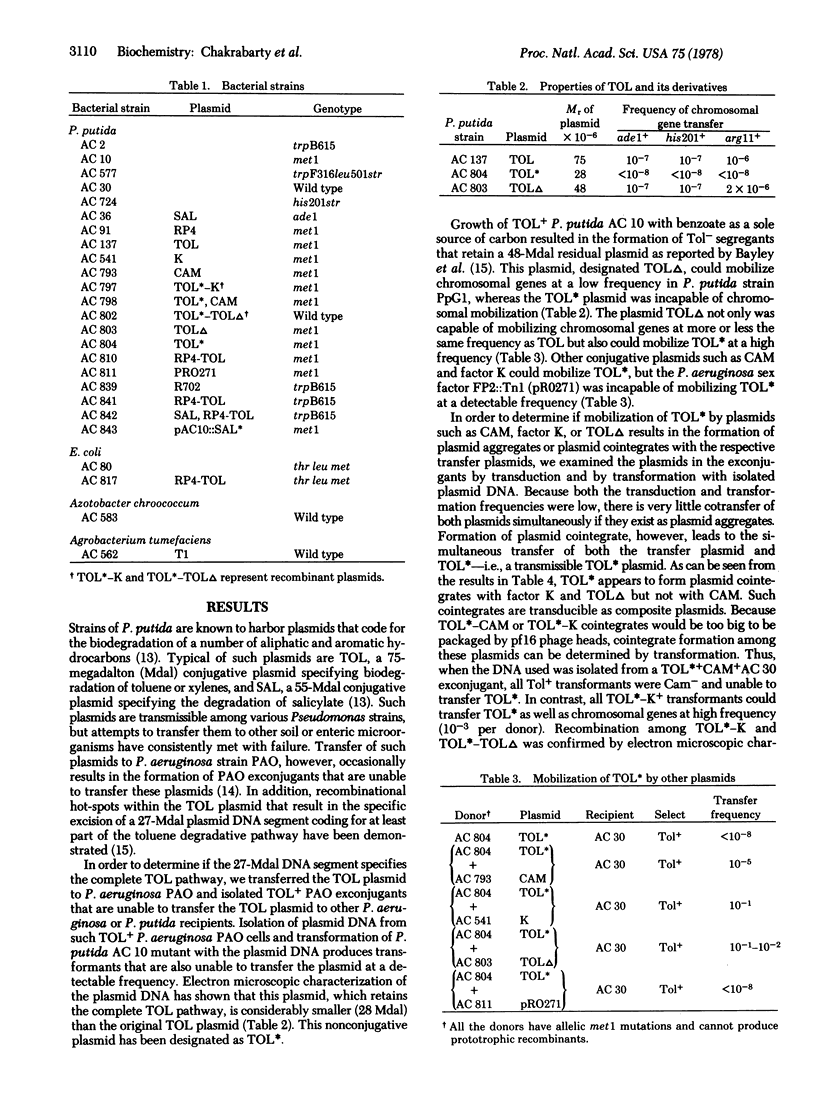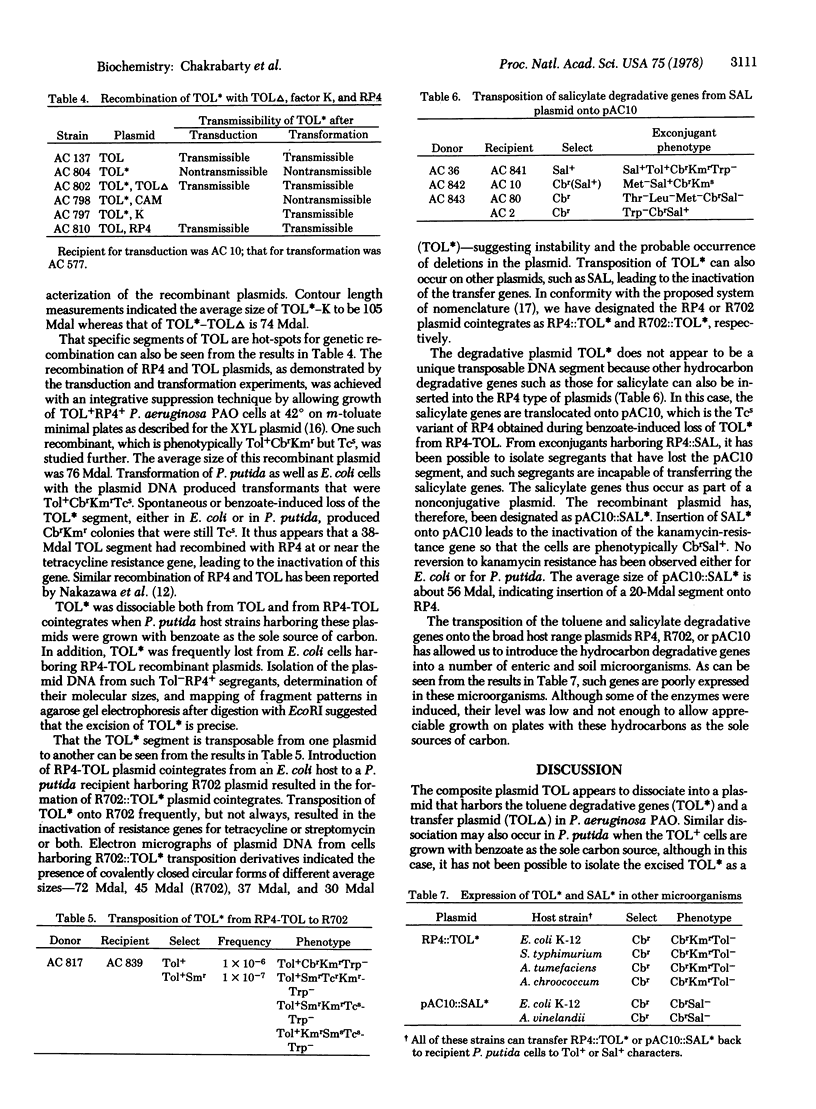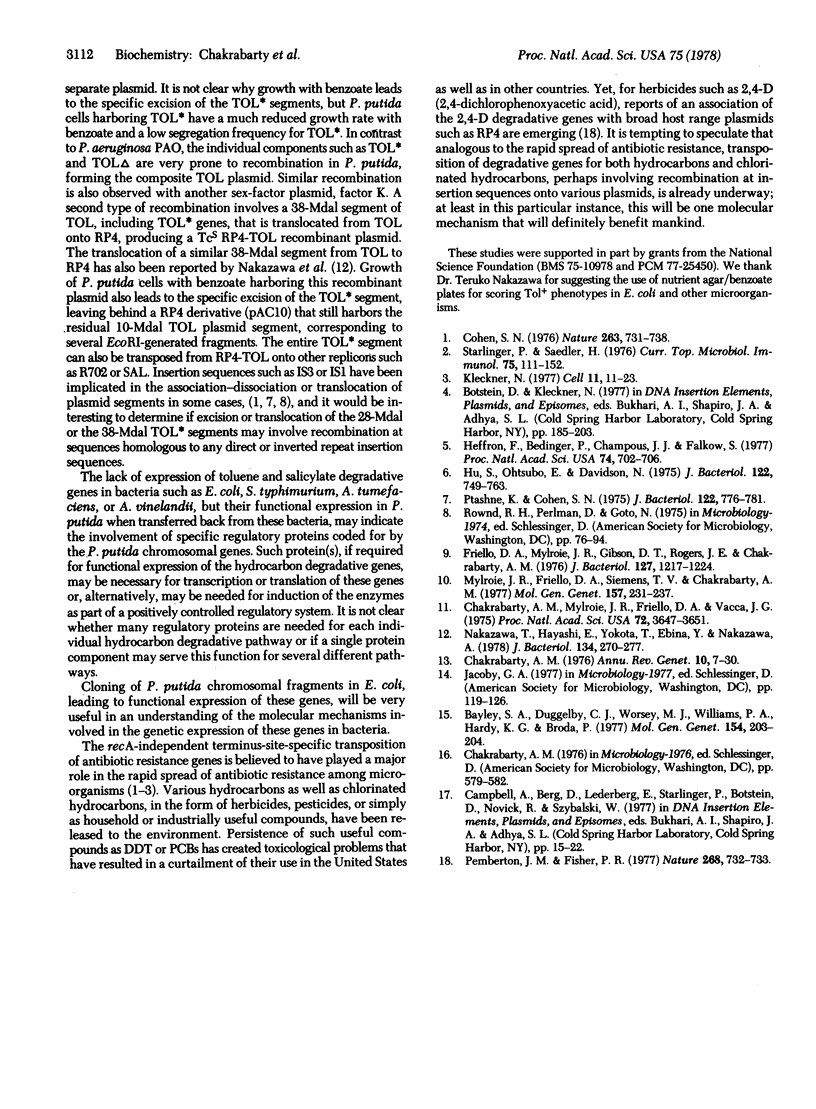Abstract
The conjugative TOL plasmid (75 Mdal), specifying biodegradation of xylenes, toluene, and trimethylbenzene derivatives, undergoes dissociation in Pseudomonas aeruginosa PAO to a nonconjugative TOL* plasmid (28 Mdal) and a transfer plasmid termed TOLΔ (48 Mdal). The TOL* plasmid is rendered transmissible through introduction of a number of conjugative plasmids such as factor K, CAM, and TOLΔ but not by the FP2 derivative pR0271. Transfer of TOL* via factor K or TOLΔ is mediated by the formation of plasmid cointegrates; no recombination is observed with CAM. A recombinant RP4-TOL plasmid (76 Mdal), which has lost resistance to tetracycline, has been isolated. The TOL* segment can be transposed from this RP4-TOL recombinant plasmid to other antibiotic resistance plasmids such as R702. A segment of DNA, specifying salicylate degradation from SAL plasmid, was transposed onto pAC10, the TOL*- derivative of RP4-TOL recombinant plasmid, which has lost resistance to tetracycline but retains the transfer genes of RP4. Transposition of the salicylate degradative genes onto pAC10 results in the loss of kanamycin resistance. It has been possible to isolate SAL+ segregants from pAC10[unk]SAL transposition derivatives that have lost the pAC10 plasmid. Such segregants harbor the salicylate degradative genes in the form of a nonconjugative plasmid (SAL*). Transfer of RP4[unk]TOL* or pAC10[unk]SAL* transposition derivatives to Escherichia coli, Salmonella typhimurium, Agrobacterium tumefaciens, or Azotobacter vinelandii results in the functional expression of the antibiotic resistance genes but not of the hydrocarbon degradative genes. Such genes, however, are fully expressed on being transferred back to Pseudomonas.
Keywords: plasmid dissociation, gene inactivation, transposon, toluene degradation, salicylate degradation
Full text
PDF



Selected References
These references are in PubMed. This may not be the complete list of references from this article.
- Bayley S. A., Duggleby C. J., Worsey M. J., Williams P. A., Hardy K. G., Broda P. Two modes of loss of the Tol function from Pseudomonas putida mt-2. Mol Gen Genet. 1977 Jul 20;154(2):203–204. doi: 10.1007/BF00330838. [DOI] [PubMed] [Google Scholar]
- Chakrabarty A. M., Mylroie J. R., Friello D. A., Vacca J. G. Transformation of Pseudomonas putida and Escherichia coli with plasmid-linked drug-resistance factor DNA. Proc Natl Acad Sci U S A. 1975 Sep;72(9):3647–3651. doi: 10.1073/pnas.72.9.3647. [DOI] [PMC free article] [PubMed] [Google Scholar]
- Chakrabarty A. M. Plasmids in Pseudomonas. Annu Rev Genet. 1976;10:7–30. doi: 10.1146/annurev.ge.10.120176.000255. [DOI] [PubMed] [Google Scholar]
- Cohen S. N. Transposable genetic elements and plasmid evolution. Nature. 1976 Oct 28;263(5580):731–738. doi: 10.1038/263731a0. [DOI] [PubMed] [Google Scholar]
- Friello D. A., Mylroie J. R., Gibson D. T., Rogers J. E., Chakrabarty A. M. XYL, a nonconjugative xylene-degradative plasmid in Pseudomonas Pxy. J Bacteriol. 1976 Sep;127(3):1217–1224. doi: 10.1128/jb.127.3.1217-1224.1976. [DOI] [PMC free article] [PubMed] [Google Scholar]
- Heffron F., Bedinger P., Champoux J. J., Falkow S. Deletions affecting the transposition of an antibiotic resistance gene. Proc Natl Acad Sci U S A. 1977 Feb;74(2):702–706. doi: 10.1073/pnas.74.2.702. [DOI] [PMC free article] [PubMed] [Google Scholar]
- Hu S., Ohtsubo E., Davidson N. Electron microscopic heteroduplex studies of sequence relations among plasmids of Escherichia coli: structure of F13 and related F-primes. J Bacteriol. 1975 May;122(2):749–763. doi: 10.1128/jb.122.2.749-763.1975. [DOI] [PMC free article] [PubMed] [Google Scholar]
- Kleckner N. Translocatable elements in procaryotes. Cell. 1977 May;11(1):11–23. doi: 10.1016/0092-8674(77)90313-0. [DOI] [PubMed] [Google Scholar]
- Nakazawa T., Hayashi E., Yokota T., Ebina Y., Nakazawa A. Isolation of TOL and RP4 recombinants by integrative suppression. J Bacteriol. 1978 Apr;134(1):270–277. doi: 10.1128/jb.134.1.270-277.1978. [DOI] [PMC free article] [PubMed] [Google Scholar]
- Pemberton J. M., Fisher P. R. 2,4-D plasmids and persistence. Nature. 1977 Aug 25;268(5622):732–733. doi: 10.1038/268732a0. [DOI] [PubMed] [Google Scholar]
- Ptashne K., Cohen S. N. Occurrence of insertion sequence (IS) regions on plasmid deoxyribonucleic acid as direct and inverted nucleotide sequence duplications. J Bacteriol. 1975 May;122(2):776–781. doi: 10.1128/jb.122.2.776-781.1975. [DOI] [PMC free article] [PubMed] [Google Scholar]
- Starlinger P., Saedler H. IS-elements in microorganisms. Curr Top Microbiol Immunol. 1976;75:111–152. doi: 10.1007/978-3-642-66530-1_4. [DOI] [PubMed] [Google Scholar]


